This article needs additional citations for verification .(February 2016) |

The following list is a list of festivals in Iran .
This article needs additional citations for verification .(February 2016) |

The following list is a list of festivals in Iran .
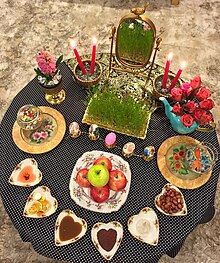
The basis of nearly all of Iranian national festivals are from its Pre-Islamic Zoroastrian era. However, there are some festivals that are celebrated exclusively by Zoroastrians and some with less extent in other communities too.
The majority of Iranian Christians are Armenian-Iranians also known as Parska-Hye who follow the Armenian Apostolic Church, an Oriental Orthodox branch of Christianity. This minority has their very own special festivals and traditions.
There is also a significant minority of Assyrian people who follow the Oriental Orthodox Christian Assyrian Church of the East and the Chaldean Catholic Church, these two church groups also have a minority of Persian followers. The followers of this church have a blend of Persian and Assyrian culture.
Iran has a large and fast growing Christian community gaining popularity amongst Persians. During Christmas times, Christmas trees can be seen from windows in Tehran and north-western provinces. Although Christmas has an official recognition in Iran, it is not a national holiday.
Iranian Jews celebrate all the same holidays as Jews worldwide, but often maintain unique customs in the observance of those holidays. Some more uniquely Iranian traditions include:

The Hijri calendar, or Arabic calendar also known in English as the Muslim calendar and Islamic calendar, is a lunar calendar consisting of 12 lunar months in a year of 354 or 355 days. It is used to determine the proper days of Islamic holidays and rituals, such as the annual fasting and the annual season for the great pilgrimage. In almost all countries where the predominant religion is Islam, the civil calendar is the Gregorian calendar, with Syriac month-names used in the Levant and Mesopotamia but the religious calendar is the Hijri one.
Eid as a name may refer to:

Nowruz is the Iranian or Persian New Year celebrated by various ethnic groups worldwide. It is a festival based on the spring equinox—which marks the first day of the new year in the Iranian Solar Hijri calendar, on or around 21 March on the Gregorian calendar.
Shaʽban is the eighth month of the Islamic calendar. It is called the month of "separation", as the word means "to disperse" or "to separate" because the pagan Arabs used to disperse in search of water.
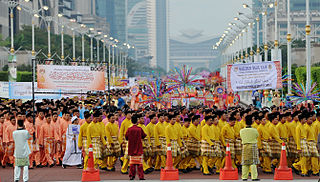
Mawlid, also known as Eid-e-Milad an-Nabi, is an observance of the day when the Islamic prophet Muhammad is reported to have been born. It is commemorated in Rabi' al-Awwal, the third month in the Islamic calendar. 12th Rabi' al-awwal is the accepted date among most of the Sunni scholars, while some Shi'a scholars regard 17th Rabi' al-awwal as the accepted date.

There are two official holidays in Islam that are celebrated by Muslims worldwide: Eid al-Fitr and Eid al-Adha. The timing of both holidays are set by the lunar Islamic calendar, which is based upon the cycle of the moon, and so is different from the more common, European, solar-based Gregorian calendar. Every year, the Gregorian dates of the Islamic holidays change.

Mid-Sha'ban is a Muslim holiday observed by Shia and Sunni Muslim communities on the eve of 15th of Sha'ban — the same night as Shab-e-barat or Laylat al-Bara’ah.

Dhu al-Hijjah is the twelfth and final month in the Islamic calendar. Being one of the four sacred months during which war is forbidden, it is the month in which the Ḥajj (Pilgrimage) takes place as well as Eid al-Adha, the “Festival of the Sacrifice.”
The event of the mubahala was an aborted attempt to resolve a theological dispute between Muslims and Christians in c. 632 CE by invoking the curse of God upon the liars. These debates took place in Medina, located in the Arabian Peninsula, between a Christian delegation from Najran, a city in South Arabia, and the Islamic prophet Muhammad, who proposed this solution probably when their discourse had reached a deadlock concerning the nature of Jesus, human or divine.
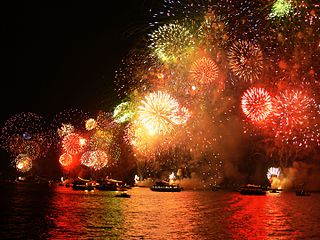
Bayram is the Turkic word for a nationally-celebrated festival or holiday, applicable to both national and religious celebrations.

Haft Seen or Haft sin is an arrangement of seven symbolic items which names start with the letter "س", the 15th letter in the Persian alphabet; "haft" (هفت) is Persian for "seven". It is traditionally displayed at Nowruz, the Iranian New Year, which is celebrated on the day of the vernal equinox, marking the beginning of spring in the Northern Hemisphere.
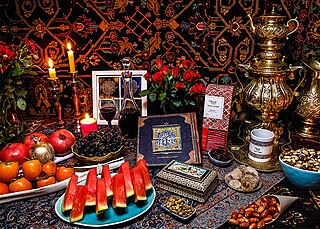
Yaldā Night or Chelle Night is an ancient festival in Iran, Afghanistan, Azerbaijan, Tajikistan, Iraqi Kurdistan, Uzbekistan, Turkmenistan, Dagestan and Turkey that is celebrated on the winter solstice. This corresponds to the night of December 20/21 (±1) in the Gregorian calendar, and to the night between the last day of the ninth month (Azar) and the first day of the tenth month (Dey) of the Iranian solar calendar. The festival is celebrated in Iran and the regions of greater Iran, including Azerbaijan, Iraqi Kurdistan, Balochi areas, Afghanistan and Tajikistan. The longest and darkest night of the year is a time when friends and family gather together to eat, drink and read poetry and Shahnameh until well after midnight. Fruits and nuts are eaten and pomegranates and watermelons are particularly significant. The red color in these fruits symbolizes the crimson hues of dawn and the glow of life. The poems of Divan-e Hafez, which can be found in the bookcases of most Iranian families, are read or recited on various occasions such as this festival and Nowruz. Shab-e Yalda was officially added to Iran's List of National Treasures in a special ceremony in 2008.
Lists of holidays by various categorizations.
Omar Koshan, also known as Jashn-e Hazrat-e Zahra, is a yearly festival held by some Twelver Shi'i Muslims in Iran. Originally, the festival commemorated the assassination of the second caliph Umar ibn al-Khattab by the Persian slave Abu Lu'lu'a Firuz.

The Mausoleum of Ali, located in Mazar-i-Sharif, Afghanistan, is a mosque which some Sufi Sunnis believe contains the tomb of ʿAlī ibn Abī Ṭālib. This site is visited particularly by Naqshbandi sufis.
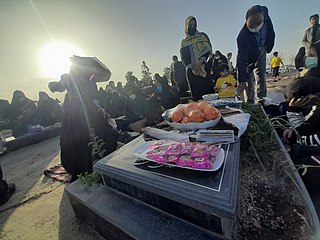
Shab-e-Barat, Cheragh-e-Barat, Berat Kandili, or Nisfu Syaaban is a Mid-Sha'ban related cultural celebration celebrated in many South Asian, Central Asian, South East Asian and Middle Eastern Muslim countries, on the 15th night of the month of Sha'ban, the eighth month of the Islamic calendar.
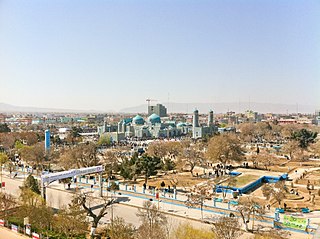
Nowruz is the beginning of springtime and a cultural holiday in Afghanistan. It is also celebrated by the majority of the Afghan diaspora around the world. Farmer's Day, which starts around the same time as the Afghan New Year, is celebrated nationwide alongside Nowruz and usually lasts around two weeks. Among other things, the celebration involves planting saplings and flowers throughout the country.

Eid al-Ghadir is an Islamic commemorative holiday, and is considered to be among the significant holidays of Shi'ite Muslims. The Eid is held on 18 Dhul-Hijjah at the time when the Islamic prophet Muhammad was said to have appointed Ali ibn Abi Talib as his successor. According to Shia hadiths, this Eid has been named "Eid-e Bozorg-e Elāhi", "Eid Ahl al-Bayt Muhammad" and Ashraf al-A'yaad.

The culture of Shiraz concerns the arts, music, museums, festivals, many Persian entertainments and sports activities in Shiraz, the capital of Fars Province. Shiraz is known as the city of poets, gardens, wine, nightingales and flowers. The crafts of Shiraz consist of inlaid mosaic work of triangular design; silver-ware; carpet-weaving, and the making of the rugs called gilim, and blankets called Jajim found in the villages and among the tribes.